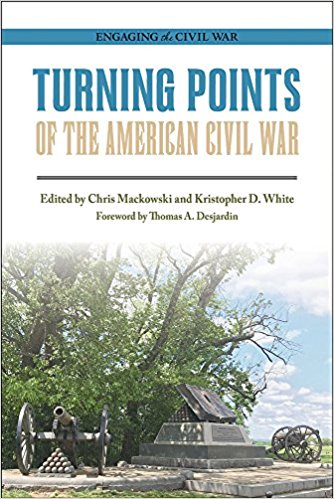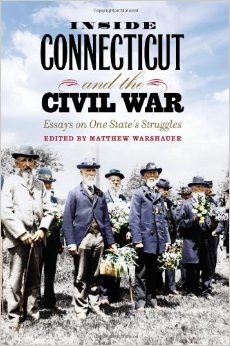Turning Points of the American Civil War edited by Chris Mackowski and Kristopher D. White. Southern Illinois University Press, 2017. Paper, ISBN: 978-0809336210. $24.50.
 In his forward to this finely crafted anthology of Civil War essays, Thomas Desjardin reminds that, “there is something within us that seeks to refine great events down to one narrow, even pinpoint occurrence.” Fortunately, editors Chris Mackowski and Kristopher White have eschewed this simplistic option and chosen an alternative path. They have assembled a team of public historians with experience at Civil War battle sites to examine a number of pivotal events during the war, all of which can reasonably claim to have been a “turning point” during the course of the conflict. Together, these essays enrich the historiography of what is certainly a turning point—perhaps the turning point—in the evolution of the United States as a modern nation.
In his forward to this finely crafted anthology of Civil War essays, Thomas Desjardin reminds that, “there is something within us that seeks to refine great events down to one narrow, even pinpoint occurrence.” Fortunately, editors Chris Mackowski and Kristopher White have eschewed this simplistic option and chosen an alternative path. They have assembled a team of public historians with experience at Civil War battle sites to examine a number of pivotal events during the war, all of which can reasonably claim to have been a “turning point” during the course of the conflict. Together, these essays enrich the historiography of what is certainly a turning point—perhaps the turning point—in the evolution of the United States as a modern nation.
Following the editors’ organizing principle that “this collection of essays assumes that the Civil War unfolded as a continuum of events with several turning points, one leading to the next to the next,” Robert Orrison begins by explaining how the Union defeat at First Manassas on July 21, 1861, led to Major General George B. McClellan being called to organize and whip-into-shape a defeated, disorganized, dispirited rabble of volunteers. In three months, he turned them into the Army of the Potomac, an army that Orrison rightly characterizes as “one of the most formidable fighting forces in the world up to that time.” Indeed, this period was a turning point because, as Orrison concludes, “the American military came of age that summer.”
A much smaller but nonetheless propitious battle occurred three months after Bull Run on a bluff high above the Potomac River. James Morgan connects the Union failure at the seemingly inconsequential Battle of Ball’s Bluff on October 21, 1861, with the creation of the Joint Committee on the Conduct of the War, a congressional oversight group that cast a long shadow over the Union’s prosecution of the war, impacted the careers of several prominent Union officers, and served as the model for twentieth century legislative panels that left an indelible mark on civilian and military affairs. Clearly, Morgan substantiates his claim that Ball’s Bluff “had implications that went beyond either its size or military significance.”
Several of the essays cover battles widely accepted as turning points. Writing about the Battle of Shiloh, Gregory Mertz dispels any lingering doubt that a Union victory was achieved irrespective of the death of Confederate General Albert Sidney Johnston. The scale of the battle and the massive casualties incurred by both sides lead Mertz to agree with the assessment of victor Ulysses S. Grant that, “after the battle, though, I gave up all idea of saving the Union except by total conquest.” Chancellorsville is often seen as the highest achievement of Robert E. Lee’s generalship. Kristopher White, however, concludes that it came at a cost greater even than the loss of his best lieutenant, Thomas Jonathan “Stonewall” Jackson. In many ways, White opines, “the battle was a hollow victory representative of a highly destructive command style bound to doom the Army of Northern Virginia.” Besides opening “Father of Waters” to the sea, the Union victory at Vicksburg signaled Grant’s ascendency as the North’s premier general. This signaled a turning point, Daniel T. Davis concludes, because, “above all, Vicksburg illustrated the capability of Grant as a commander, who was flush with ‘dogged persistence’ and an ability to execute the war aims of the Lincoln administration.”
Historic turning points can hinge on the stroke of a pen or a turn in the road. Stephen Davis analyzes why Confederate President Jefferson Davis and his advisors chose to relieve General Joseph Johnston and replace him with John Bell Hood when they did. Davis documents the series of events that flowed from that fateful decision, even before Hood eventually wrecked the Confederacy’s premier army in the west during his disastrous Tennessee Campaign of November-December 1864. Conversely, Ryan Longfellow dramatically portrays Grant’s singular decision after the May 5-7, 1864 Battle of the Wilderness to turn his army south on the Brock Road toward Richmond rather than north toward the Rapidan River. “For the first time,” Longfellow writes, “the Army of the Potomac engaged Robert E. Lee and, at the conclusion of the battle, did not retreat. It did not sit still. It did not meekly follow behind.” Grant’s decision clearly indicated that there would be “no turning back.”
Finally, turning points of the Civil War need not be limited to battles fought. Kevin Pawlak successfully argues that “the Emancipation Proclamation, one of our country’s most misinterpreted documents, affected the outcome of the war diplomatically and militarily, and set the United States on a new course toward freedom.” Rea Andrew Redd documents various turning points during the 1864 presidential election. Redd lays out why “the renomination and reelection of Lincoln were not foregone conclusions,” and why his election to a second term drove the penultimate nail into the coffin of Confederate nationhood.
Any review would be incomplete without mentioning the eloquent introductions written by the editors for each of the essays and the simple, yet informative maps penned by Hal Jespersen. Both significantly contribute to the overall excellence of Turning Points of the American Civil War.
Gordon Berg pens articles and reviews for many Civil War publications. He lives in Gaithersburg, Maryland.




